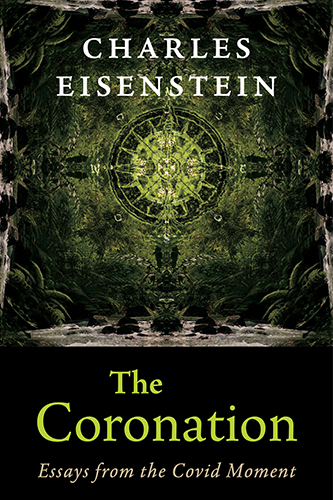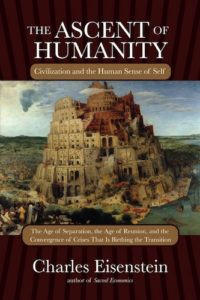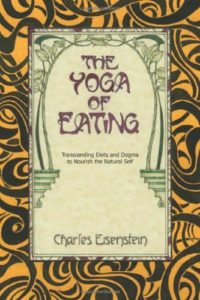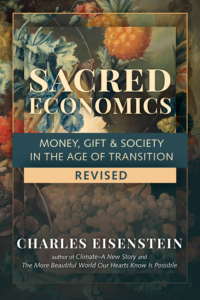The Ascent of Humanity
Chapters
Chapter 5: The World Under Control
The Great Indoors
The white man builds a shelter, and it becomes his prison. . . . he separates himself from the earth and refuses to budge. Therefore he is always sick.
— Tom Brown, Jr.
It is significant that school almost always happens indoors, in William Torrey Harris’s “dark, airless, ugly places”, because the indoors is perhaps the most concrete manifestation of the separate human realm we have created. The engineering of human nature happens in a physical setting from which nature has been removed as well.
Harking back to that most primeval model of separation—cell homeostasis—we create another level of self-other distinction with our buildings. Using bricks and mortar instead of lipid membranes, vacuum cleaners and air conditioning instead of ion pumps, we maintain our buildings in a state far removed from thermodynamic equilibrium by exporting entropy into the environment.
This is more than an adventitious metaphor. The indoors is the epitome of control, a place in which any undomesticated life forms (ants, mice, etc.) are unwelcome, where the processes of nature (such as decay and soil buildup) are arrested, a place where even the climate is controlled. Buildings, like cells, separate the universe into two parts, indoors and outdoors, one of which is regulated and associated with self, and the other wild and associated with other. For the individual human this self-other dichotomy is most pronounced in that unique building called the home: hence the intense feeling of violation when it is burglarized, and the near-existential unease some people feel when they discover an infestation of ants or mice.
In many ways the suburban yard is an extension of the indoors, in that the only life forms in a well-manicured lawn are those expressly permitted to be there, just as the landscaped environment is an extension of the public or corporate indoors. The culmination of this would be the final elimination of the wild altogether: a climate-controlled, genetically-engineered world where no life exists that is not planned and directed. It would be, in effect, the conversion of the entire planet into a Great Indoors, a vision embodied in the bubble-domed cities of futurists since the 1950s.
The domestication of physical space runs parallel to the conversion of the outdoor, public life into the indoor, private life. As communities have unraveled and public life evaporated, the realm of the private has grown correspondingly. One indication of this is that the average size of the suburban home has more than doubled since 1949 (even as average family size fell by one-third)[33]. The realm of the private is the realm of the separate self, and that is the realm of the indoors. Thus, as more and more of life is privatized, functions that were once public and outdoors have migrated into the private home. Among them: theater—having evolved from fully participatory enactments of myth and legend, to small-scale public performances and vaudeville, to the private in-home viewing of mass-produced culture like television and film; music—again having evolved from universal participation to public performance of increasing scale to the private listening experience that reaches its extreme with the earphone; eating—again formerly a community activity; and finally and most significantly, play.
A vast change has overtaken suburbia in the past two generations. The archetypal suburb was first and foremost because that’s where people moved to raise families. Lawns and parks and lots of other families with children defined the suburb as a children’s paradise. In the cultural mythos of the American Dream, childhood proceeds along the lines of the Little Rascals or Dennis the Menace or the Berenstain Bears: long days playing outside with other children, building clubhouses and forts, jumping rope and playing hopscotch, catching frogs and turtles, biking all over the place . . . pickup games of baseball and tag . . . tea parties with the other girls . . . sledding and snowball fights. Children were seldom at home. They were at a neighbor’s house, or over at the playground, or the vacant lot, or down by the pond. It didn’t matter as long as they were back for dinner. Until recently, play was outdoors, public, and free of charge.
Where are the children now? This is the question I asked myself one winter Saturday as I walked through the empty suburban streets and past the deserted playgrounds of my home town. Finally I saw a tiny figure dressed in a pink snowsuit, a little girl standing at the edge of her yard, waist deep in the snow. She dipped her mitten into the snow for a taste. Four hundred families in this neighborhood, most of them with children, and only a single five-year-old outdoors on a Saturday afternoon. And I cannot imagine her staying there very long, alone in the snow, the stillness broken only by the passing cars and that odd-looking lone pedestrian. Her life happens indoors.
A major theme of this chapter is how important it is for children to be free to explore their limits and experience the consequences of their mistakes. In large part, this means letting them be out in the world, that is, outdoors, in an environment not wholly under control. I would love to tell everyone, “Just let your kids be free,” but unfortunately the matter is not so simple. Embedded as we are in modern society, much of the control imposed upon children is structural in origin and beyond the power of parents to easily alter. Furthermore, control on all levels has engendered the paradox I emphasize throughout this chapter; namely, it has made the world much less safe. In other words, I do not think all you parents out there are control freaks, nor am I going to advocate letting your children out right now to play in traffic.
Wait, let me contradict myself. I do think you—nearly all of us—are control freaks, simply by virtue of our membership in this culture. I also think that it is perfectly fine for children to play in traffic. But not traffic as it is in the world under control (I’ll explain that in a moment). While parents do tend to overestimate the dangers “out there,” it is dangerous—more dangerous than it was a generation ago. By getting the world under control, we have made it more dangerous, a truism we can apply as much to the war on disease and the war on terrorism as we can to that archetype of ordered, controlled modern life, suburbia.
Here are two ways in which control has made suburbia more dangerous for children. First, by moving life into the privacy of indoors, our neighbors have become strangers and we no longer feel at ease knowing that “someone will look out for them.” Of course, the anonymity of the contemporary suburb owes itself also to nationwide patterns of mobility, which obliterate the cohesiveness of communities, and to television, which replaces local stories about so-and-so’s granddad and the neighbor’s uncle down the street with stories beamed in from remote locations about people and events that have nothing to do with the community. Whereas in the past we talked about people we knew, today we talk about characters from TV shows and professional sports teams. Television, originally trumpeted as a means to open us up to a wider world, has had the perverse effect of cutting us off from the people around us. Television is an indoor activity, inherently private and isolating. And when there are no other kids playing outside, and the town is full of strangers, what else is there to do?
The other defining technology of twentieth-century America, the automobile, has also exacerbated separation and brought life indoors. It is ironic indeed that the car, which in theory should bring people closer together by reducing travel time, has had the opposite effect. Consider that without the automobile, suburbs as we know them would not exist. Without the automobile, every house needs to be within walking distance to various shops, post offices, schools, and a train station. It is no accident that older towns and cities, built before the Age of the Automobile, are much denser than the sprawling suburbs-without-a-city that comprise newer metropolitan areas.
In depopulating the outdoors we have conceded it to cars, creating space inhospitable or downright dangerous to people, especially children, driving them even more indoors. The usual vicious circle of technology. The outdoors becomes the road, not a real place at all but merely a distance to be traversed between destinations. The apotheosis of this trend, the superhighway, goes so far as to prohibit pedestrians—that is, people—altogether. By bringing the world under control, we have made huge sections of it off limits, a development presaged by the reduction of the infinite described in “The Origins of Technology”.
Whether for children or adults, the migration of life indoors is so extensive that some people feel uneasy to be outside at all. They perceive the outdoors to be not entirely comfortable, safe, or secure—it is the undomesticated realm that is not under complete control. Often this perception manifests physically as intolerance to even modest levels of heat and cold, pollen, biting insects, and so on—another example of how technology generates dependency on technology. The less we utilize and challenge our capacities, the more those capacities wither. Could this be another type of physiological capital we are converting into money? (Not to say life indoors causes pollen allergies, though I doubt that many rabbits or deer suffer from such sensitivities.) Similarly, animals and pre-technological human beings are far more tolerant of temperature extremes than are civilized humans.
No matter. When life happens in a box, there is hardly a need to go outdoors at all. In the winter some of my neighbors literally go weeks without spending more than two minutes at a time outdoors—the time it takes to get from parking lot to building. The same is increasingly true in summertime as well, when life takes us from air-conditioned home to air-conditioned car to air-conditioned store or office.
Spend some time in less developed countries and you’ll be amazed at how much more time people spend outdoors, and thus how life there is correspondingly much more public. When houses are small, close together, and not very soundproof, as is the case in many parts of the world, and when significant life functions happen outside anyway, then our selves are more public too—we are better known and our stories are familiar to all around us. Under such circumstances the illusion of the discrete and separate self is less persuasive. When our traumas and our triumphs happen in an insulated box, it is easy to feel we are alone in the universe. But when we are not so socially isolated—when the whole village can hear us argue or make love, see that a child is ill, watch the baby’s first steps—then we see our words, emotions, actions and states of being ripple out into the community and bounce back to affect ourselves. It becomes so much more obvious that we are not discrete subjects alone in an objective universe but rather intimately connected with the world that environs us.
New trends in urban design toward denser development thus have a significance far beyond their ecological and community-building benefits. Just as the isolated suburban box corresponds to an isolated self inside a fortress of security and faux-independence, a community of shared public spaces corresponds to a shared self, for whom the private realm of me and mine is limited. I am not advocating the abolition of that realm, neither in its external manifestation as a private space, nor its interior manifestation as the ego. It’s just that today, that realm has expanded like a tumor to consume nearly the whole of life.
By bringing too much of life into the realm of the private, the separate self, the indoors, we end up with less life, not more: less security, less independence, less safety, and an ever-increasing need for more and more control. A recent innovation in traffic engineering gives us a glimpse of another way. Known as “second-generation” traffic engineering, it borrows from Dutch woonerf design principles that blur the boundary between street and sidewalk.[34] In many ways it is actually the antithesis of “engineering”, which seeks the optimum control of vehicular and pedestrian traffic through the “triple E” paradigm of traffic control: engineering, enforcement, and education. Instead, it foregoes control, dispensing with all traffic lights, stop signs, crosswalks, and lane markings, and inserting trees and other objects right in the middle of roads and intersections. Children can play in the street again!
“What the early woonerf principles realized,” says [urban designer] Hamilton-Baillie, “was that there was a two-way interaction between people and traffic. It was a vicious or, rather, a virtuous circle: The busier the streets are, the safer they become. So once you drive people off the street, they become less safe.”
Contrast this approach with that of the United Kingdom and the United States, where education campaigns from the 1960s onward were based on maintaining a clear separation between the highway and the rest of the public realm. Children were trained to modify their behavior and, under pain of death, to stay out of the street. “But as soon as you emphasize separation of functions, you have a more dangerous environment,” says Hamilton-Baillie. “Because then the driver sees that he or she has priority. And the child who forgets for a moment and chases a ball across the street is a child in the wrong place.”
What a beautiful illustration of how control creates the symptoms we think it is addressing! But it also suggests a further point—to relinquish control does not mean to disengage from the world or to be careless. The chaos of the woonerf street works because it forces us to be more engaged and more alert, not less. Similarly, the animal or primitive human was far more aware and observant of her environment than we are today, to the point where indigenous people’s powers of observation seem well-nigh magical. To relinquish control is not to surrender life; it is to surrender to life, to engage life more fully, to let it in, to open to its unreduced repletion.
[33] Statistics from Habitat for Humanity, “Creeping Affluence”, http://www.lawrencehabitat.org/About/Library/creepingaffluence.pdf
[34] The details in this paragraph and the quotations following it are taken from Linda Baker, “Why don’t we do it in the road?” May 20, 2004, http://archive.salon.com/tech/feature/2004/05/20/traffic_design/index.html. However, anyone who has lived in a third-world city has already seen this model in action.






